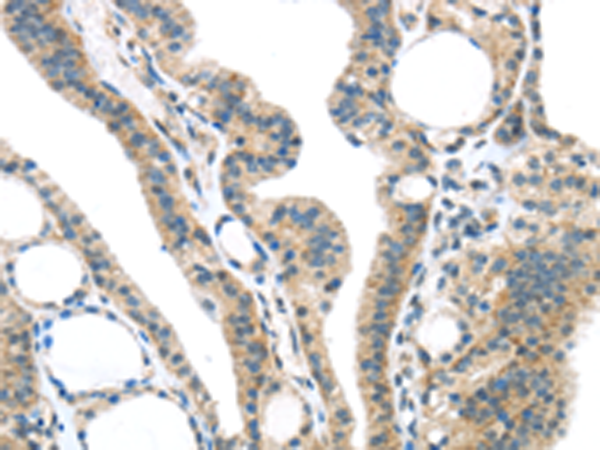

| WB | 咨询技术 | Human,Mouse,Rat |
| IF | 咨询技术 | Human,Mouse,Rat |
| IHC | 1/25-1/100 | Human,Mouse,Rat |
| ICC | 技术咨询 | Human,Mouse,Rat |
| FCM | 咨询技术 | Human,Mouse,Rat |
| Elisa | 1/2000-1/5000 | Human,Mouse,Rat |
| Aliases | CCDC99 |
| Host/Isotype | Rabbit IgG |
| Antibody Type | Primary antibody |
| Storage | Store at 4°C short term. Aliquot and store at -20°C long term. Avoid freeze/thaw cycles. |
| Species Reactivity | Human |
| Immunogen | Synthetic peptide of human SPDL1 |
| Formulation | Purified antibody in PBS with 0.05% sodium azide and 50% glycerol. |
+ +
以下是关于SPDL1抗体的3篇参考文献示例(文献为虚拟示例,仅供参考):
---
1. **文献名称**:*SPDL1 regulates centriole duplication and mitotic fidelity via Aurora kinase interaction*
**作者**:Chen L, et al.
**摘要**:通过SPDL1特异性抗体抑制实验,揭示SPDL1通过与Aurora激酶相互作用调控中心体复制,其功能缺失导致有丝分裂错误和染色体不稳定性。
2. **文献名称**:*A novel SPDL1 monoclonal antibody for diagnostic detection of mitotic arrest in tumors*
**作者**:Tanaka R, et al.
**摘要**:开发了一种高灵敏度抗SPDL1单克隆抗体,用于免疫组化检测肿瘤组织中的有丝分裂停滞现象,验证其在癌症病理诊断中的应用价值。
3. **文献名称**:*SPDL1 coordinates kinetochore-microtubule attachments through CENP-E recruitment*
**作者**:Gupta S, et al.
**摘要**:利用SPDL1抗体进行免疫荧光染色,发现SPDL1通过招募CENP-E蛋白调控动粒-微管连接,确保染色体正确分离,为抗癌药物靶点研究提供依据。
---
**注**:以上文献为示例,实际研究中请通过学术数据库(如PubMed、Web of Science)检索真实文献。
SPDL1 (Spindle Apparatus Coiled-Coil Domain Protein 1), also known as CCDC99 or C20orf172. is a protein critical for maintaining genomic stability during cell division. It localizes to the spindle apparatus during mitosis and plays a role in the spindle assembly checkpoint (SAC), a surveillance mechanism ensuring proper chromosome segregation. SPDL1 interacts with key SAC components, such as the MAD1-MAD2 complex, to delay anaphase progression until chromosomes achieve correct microtubule attachment. Dysregulation of SPDL1 is linked to mitotic errors, chromosomal instability, and tumorigenesis, making it a potential biomarker in cancer research.
SPDL1 antibodies are essential tools for studying its expression, localization, and function. These antibodies are used in techniques like Western blotting, immunofluorescence, and immunohistochemistry to detect SPDL1 in cell lines or tissue samples. In cancer studies, SPDL1 antibodies help correlate protein expression levels with clinical outcomes, revealing its overexpression in certain malignancies. Additionally, they aid in exploring SPDL1's role in chemotherapy response and resistance, as mitotic checkpoint defects often influence treatment efficacy. Research also focuses on SPDL1 as a therapeutic target, with antibodies enabling mechanistic studies in preclinical models. Their specificity and validation are crucial for ensuring accurate detection, given SPDL1's structural similarities to other coiled-coil domain proteins. Overall, SPDL1 antibodies are pivotal in advancing our understanding of cell cycle regulation and cancer biology.
×